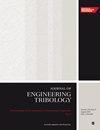Analysis of lubrication performance and flow field for lead-bismuth bearings considering the temperature-viscosity effect
IF 1.8
3区 工程技术
Q3 ENGINEERING, MECHANICAL
Proceedings of the Institution of Mechanical Engineers, Part J: Journal of Engineering Tribology
Pub Date : 2023-11-15
DOI:10.1177/13506501231210905
引用次数: 0
Abstract
Lead-bismuth bearing performance and dynamic properties are crucial for ensuring the steady operation of lead-bismuth liquid metal pumps since they are one of the primary supporting elements in the lead-bismuth cold fast reactor system. To study and analyze the lubrication performance of lead-bismuth bearings as well as the influence of the viscous-temperature property of lead-bismuth medium on the bearing load performance, a hydrodynamic model based on CFD (Computational Fluid Dynamics) is established. The performance of lubrication comprises addressing the static and dynamic properties of lead-bismuth bearings. The pressure and temperature flow fields of the Lead-bismuth bearing under various working conditions were determined by solving the N-S equation and energy equation. The numerical findings demonstrate a clear strip-like distribution in the temperature and pressure flow fields of the lead-bismuth bearing. The pressure flow distribution in the working and feedback grooves is symmetrical, the temperature flow distribution is isotropic, and the temperature increase is mostly proportional to the rotation speed. As the rotation speed becomes larger, the force in the y-direction, power loss, and leakage flow rate all increase. Bearings with small radius clearance and greater rotation speeds have superior stability than those with big radius clearance and lower speeds. The findings of this paper serve as a point of reference for the study of the viscosity-temperature effect and lubrication theory of lead-bismuth bearings and supply the foundation for subsequent rotor dynamics calculations.考虑温度-粘度效应的铅铋轴承润滑性能和流场分析
铅铋液态金属泵是铅铋冷快堆系统的主要支持元件之一,因此铅铋轴承的性能和动态特性对于确保铅铋液态金属泵的稳定运行至关重要。为了研究和分析铅铋轴承的润滑性能以及铅铋介质的粘温特性对轴承负载性能的影响,我们建立了一个基于 CFD(计算流体动力学)的流体动力学模型。润滑性能包括铅铋轴承的静态和动态特性。通过求解 N-S 方程和能量方程,确定了铅铋轴承在各种工况下的压力和温度流场。数值结果表明,铅铋轴承的温度和压力流场呈明显的条状分布。工作沟道和反馈沟道中的压力流分布是对称的,温度流分布是各向同性的,温度升高主要与转速成正比。随着转速的增大,Y 方向上的力、功率损失和泄漏流量都会增大。半径间隙小、转速高的轴承比半径间隙大、转速低的轴承具有更高的稳定性。本文的研究结果为研究铅铋轴承的粘温效应和润滑理论提供了参考,并为后续的转子动力学计算奠定了基础。
本文章由计算机程序翻译,如有差异,请以英文原文为准。
求助全文
约1分钟内获得全文
求助全文
来源期刊

CiteScore
4.20
自引率
5.00%
发文量
110
审稿时长
6.1 months
期刊介绍:
The Journal of Engineering Tribology publishes high-quality, peer-reviewed papers from academia and industry worldwide on the engineering science associated with tribology and its applications.
"I am proud to say that I have been part of the tribology research community for almost 20 years. That community has always seemed to me to be highly active, progressive, and closely knit. The conferences are well attended and are characterised by a warmth and friendliness that transcends national boundaries. I see Part J as being an important part of that community, giving us an outlet to publish and promote our scholarly activities. I very much look forward to my term of office as editor of your Journal. I hope you will continue to submit papers, help out with reviewing, and most importantly to read and talk about the work you will find there." Professor Rob Dwyer-Joyce, Sheffield University, UK
This journal is a member of the Committee on Publication Ethics (COPE).
 求助内容:
求助内容: 应助结果提醒方式:
应助结果提醒方式:


